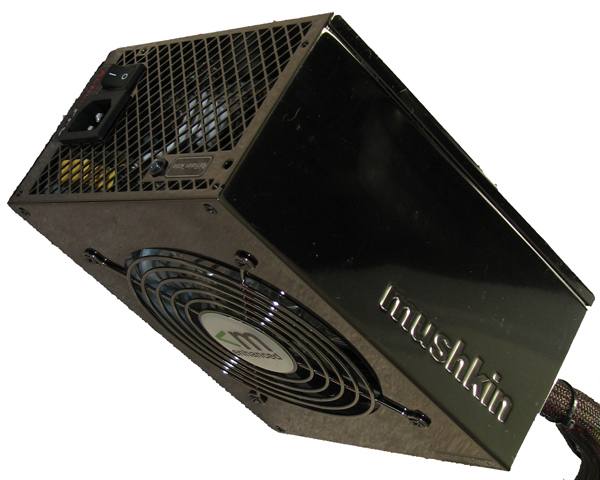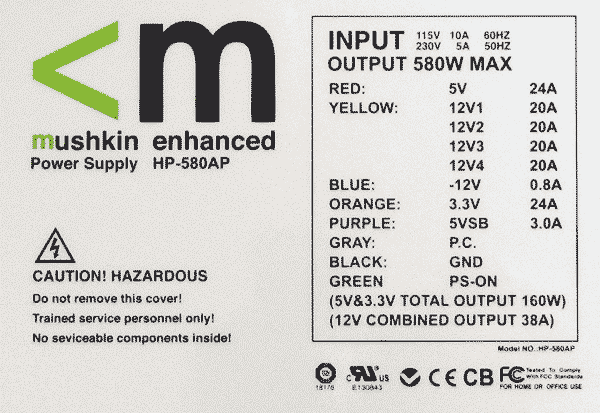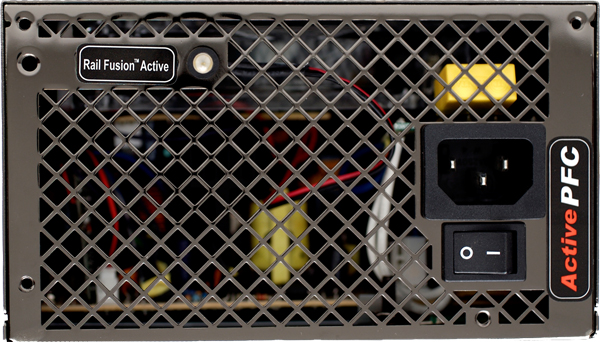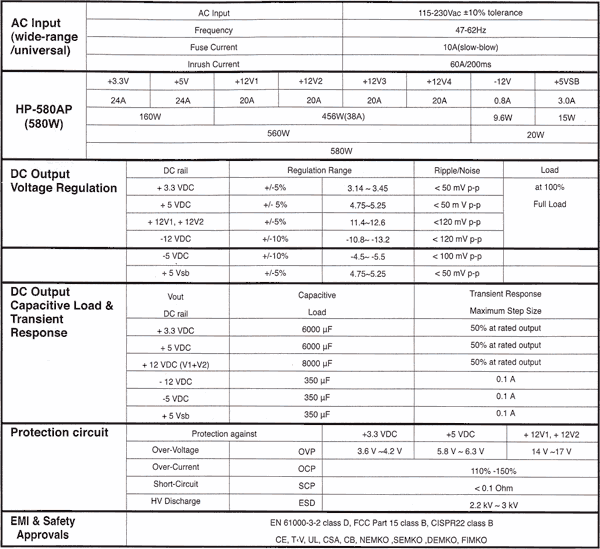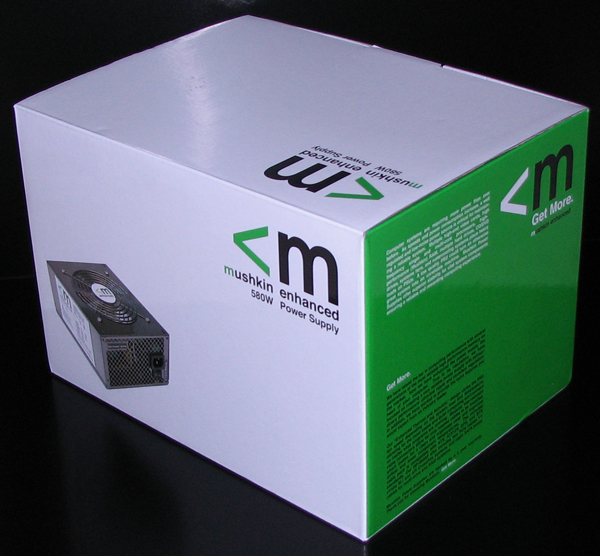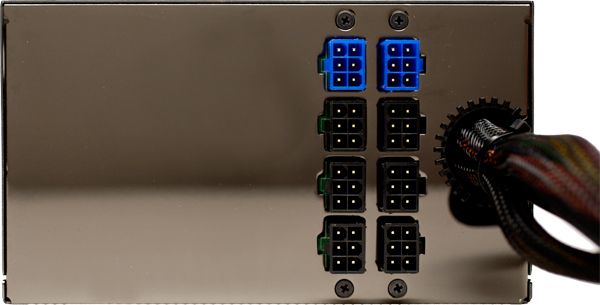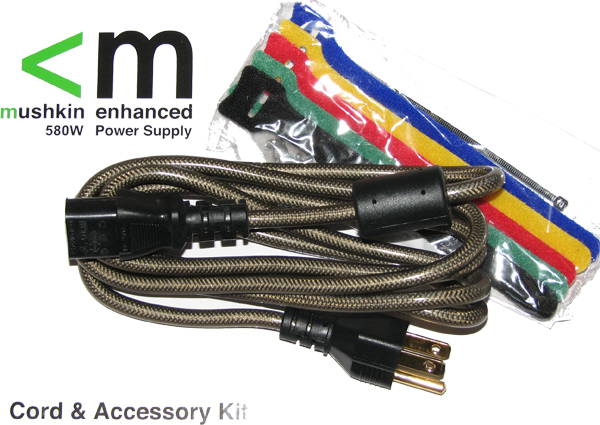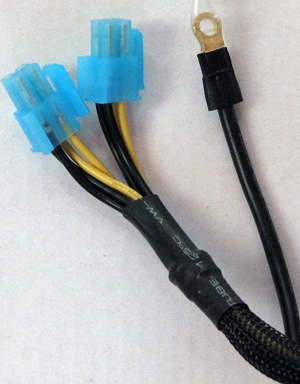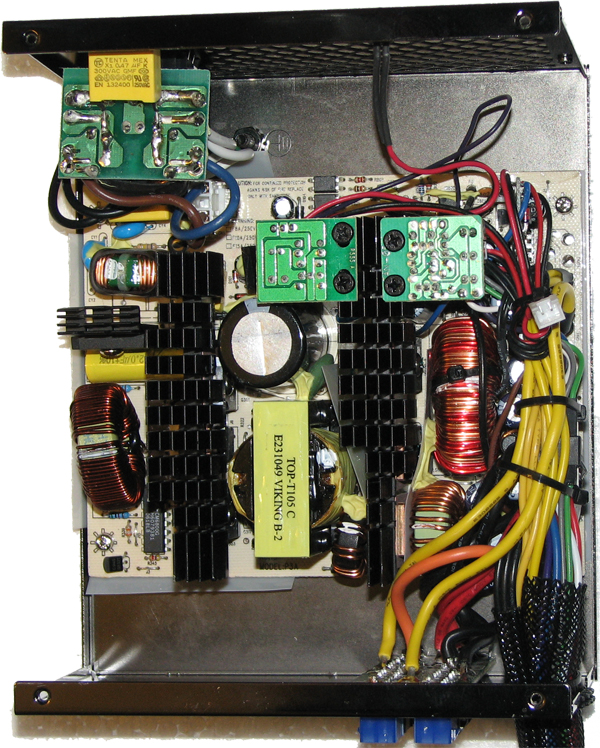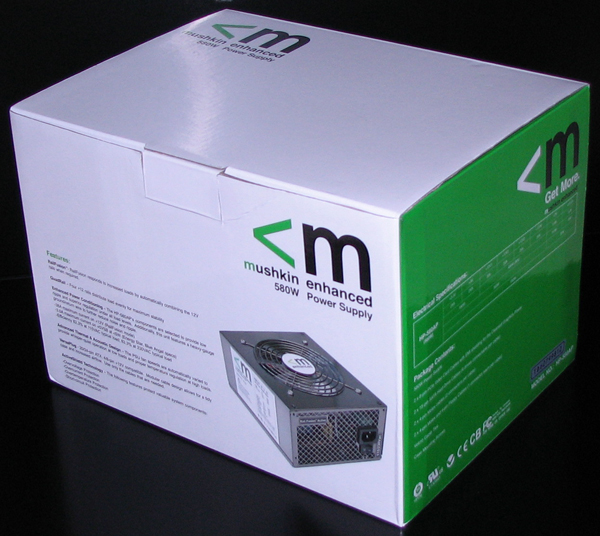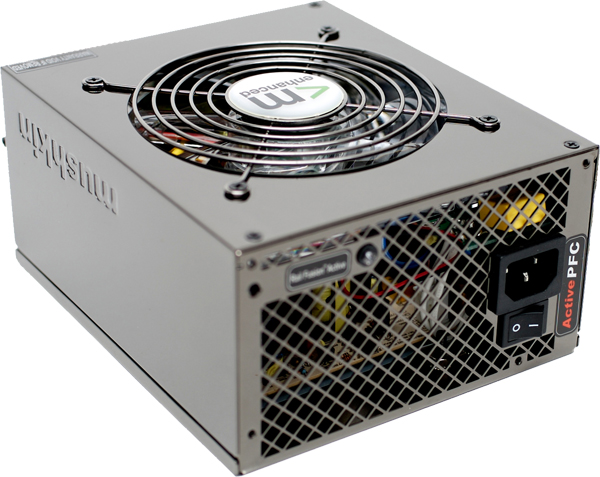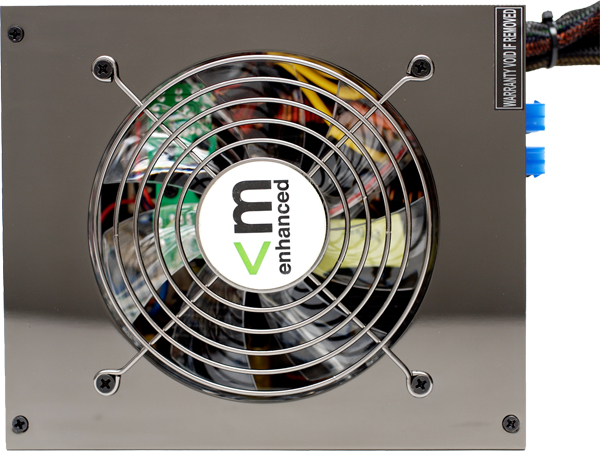The next generation of power supplies has arrived with Mushkin’s Enhanced series featuring RailFusion. The four 12V rails allow the PSU to distribute power more evenly, resulting in a more stable system. Available with 580 Watts, your power needs are met for even the most cutting edge components. Mushkins HP-580AP is designed to handle dual processors, dual graphics cards, and just about anything else you can throw at it – perfectly. Additionally, Mushkin’s “Enhanced Thermal & Acoustic Design” will automatically vary the PSU fan speed depending on the system load and temperature, allowing for the most stable and quiet computing environment no matter what programs are running.
INTRODUCTION
The power supply unit is the single most important part of any computer. Regardless of the system there is a given rule: whether it be a simple workstation with integrated components or an advanced gaming system with every fresh technology available, everything requires power to operate. As anyone who has suffered the failure of a low-end power supply will tell you: not all power supply units (PSU’s) are created equal. While every journalist has their own system for reviewing a power supply, my review will take a very detailed look at the Mushkin HP-580AP PSU at every angle and submit the unit to battery of torture tests in order to ensure it will provide any computer system with stable power.
This year alone the computer industry has made huge leaps in power supply technology. Single rail power supplies were dominantly standard heading into 2006. Now just one year later, we have seen a very sudden shift making dual-rail power supplies the most common configuration. As power supply technology continuously evolves, the number of power rails will keep getting higher in these newer PSU’s. What used to be bleeding edge with five rails is getting closer to the average with each new release. Mushkin helps to drive power supply evolution forward and offers the HP-580AP with four power rails to enhance power stability under load; all at a reasonable price.
Mushkin 580W HP-580AP Power Supply
The next generation of power supplies has arrived with Mushkin’s Enhanced series featuring RailFusion. The four 12V rails allow the PSU to distribute power more evenly, resulting in a more stable system. Available with 580 Watts, your power needs are met for even the most cutting edge components. Mushkins HP-580AP is designed to handle dual processors, dual graphics cards, and just about anything else you can throw at it – perfectly. Additionally, Mushkin’s “Enhanced Thermal & Acoustic Design” will automatically vary the PSU fan speed depending on the system load and temperature, allowing for the most stable and quiet computing environment no matter what programs are running.
With a long week of testing behind me, I will prove if Mushkin’s HP-580AP PSU is more marketing hype to draw you in, or if it is in fact a product worth the bragging rights for that I can personally recommend buying. One thing is certain even before the testing begins: at a manufacturers suggested retail price of $139, the Mushkin HP580-AP already offers the latest quad-rail technology and modular cable management for less then the cost of nearly all of the other power supplies on the market in its range.
Mushkin: The Company’s Overview
Founded in 1994, Mushkin is best known for producing “Enhanced” memory modules. Located at the base of the Rocky Mountains in Denver, Colorado Mushkin provides performance enhanced computer products to users worldwide. Exceptional quality, enhanced performance and unparalleled customer support are what make Mushkin products the best in the industry.
Mushkin products include an enhanced power supply line and a complete selection of memory upgrades for desktops, servers and notebooks – we offer something for everyone from business user to gamer. Our enhanced memory products are available in several performance categories from standard to extreme, with our REDLINE series in a class of its own. Our Enhanced power supply line offers superb regulation and ripple characteristics, modularity and plenty of power to supply the most demanding systems.
With customers including everyone from Apple Computers and NASA to gamers and web browsers, Mushkin knows what is important to customers – enhanced performance with uncompromised quality. With Mushkin you Get More.
Features & Specifications
The standard features of Mushkin PSU’s enable wide range compatibility with the latest connector and power standards. Also included are advanced power and thermal management with safeguards to protect installed components.
Features
VersaPlug – Mushkin’s innovative slide-in 20/24-pin and 4/8-pin universal motherboard connectors allow wide-spread compatibility with motherboards using the latest ATX/BTX/EPS standards. Allows for an organized case and improves airflow by using only the required cables.
- Eight SATA 15-pin HDD connectors are integrated in all Mushkin Power Supplies.
- Two 6-pin PCIe video card power connectors which have fully coated, slip proof EMI-shielded cables.
- Modular cable design allows for clean cable management and increased case airflow.
Enhanced Power Conditioning – The HP-580AP’s components are selected to provide ultra-low ripple and superior regulation under varying load. Additionally, this unit features a heavy-gauge ground/return wire to further reduce noise and ripple. All these features provide ultra-low ripple (1%) and superior voltage regulation (1%) under all load levels.
- 38A Maximum current on +12V (RailFusion mode)
- 3A Maximum current on +5VSB at <5W
- 115V – Typical load 82.3%
- 230V – Typical load 83.3%
RailFusion – When high draw devices exceed the maximum allowed current per 12V rail (20A), this feature combines the rails to avoid overcurrent shutdown. THe green LED on the back of the unit will illuminate when RailFusion is active.
Mushkin HP-580AP Rear View
ActiveShield Technology – The HP-580AP PSU incorporates active protection for installed components. These protection measures include:
- Overvoltage protection
- Undervoltage protection
- Overcurrent protection
- Undercurrent protection
- Overtemperature protection
- Short circuit protection
Power Factor Correction – Facilitated with the universal input 90VAC ~ 250VAC active PFC with the PF value 0.96 at 115V or 230V with the EN 61000-3-2, class D standards.
Enhanced Thermal & Acoustic Design – Under light load, the fan speeds are reduced for quiet computing. When loading is increased, the PSU fan speeds are increased for proper temperature regulation.
Specifications
Packaging
Packaging may very well influence a purchase, or possibly even draw your eye to the product initially. Of course, a special value should be placed on protective packaging beyond the average, and the HP-580AP is no exception. The cardboard package which Mushkin uses is ideal for retail shelves and warehouses, but it is not suitable for standalone shipping and should be packaged with protective surroundings for shipping. However, if you are like most people including myself, the packaging is quickly discarded once you have the unit installed and it has survived initial break-in and testing.
Mushkin HP-580AP Retail Packaging: Front
Included Components
(1) HP-580AP Power supply unit with 24-pin main connector with detachable 4-pin section, and a 12V 4-pin connector for single CPU systems
(1) User Manual in English
(1) Shielded and insulated AC power cord
(4) Mounting screws
(2) Colored Velcro cable bands
Mushkin HP-580AP Modular Connections
The modular cable groups includes:
(2) 4-Pin Molex peripheral and 4-Pin Floppy cable group
(2) 4-Pin Molex peripheral cable group
(2) 15-Pin SATA cable groups with four connectors per group
(2) 6-Pin PCI Express cables with EMI shielding
Even the Power Cord is Enhanced!
As evidenced in the contents for the HP-580AP, the floppy connector is a soon to be extinct feature in the power supply industry. There has been a slow trend to remove this connector completely, but I suspect it will be at least another year before we have seen the last of it. Until the BIOS can be upgraded from a USB flash drive, there will be a need for floppy drives.
In addition to the standard set of connectors, Mushkin includes a specialized grounding connector:
Combine 4-Pin Connectors for 8-Pin Compatibility
Braided, Shielded, and Protected PCI-E Cable
It certainly appears as though Mushkin has concentrated on presentation with the Enhanced series of power supply units. The standard device connectors come with nylon protective braided covers, and the PCI-E VGA cables come with EMI ferrite cores and see-through covers which reveal the braided shielding. In addition, the length of each cable is 550mm from power supply to connector. It may seem unreasonable, but it would be beneficial to cover the connectors with protective rubber caps to avoid accidental contact with components which could result in a fire or electrical shock. This additional safety feature is not included with the Mushkin HP-580AP power supply units, but it is recommended.
Internal Components
The internal view of the Mushkin HP-5880AP looks nothing like most other power supply units you might be used to seeing. The voltage regulator heatsinks are an improved design, and a pleasant departure from the sheared large-gauge aluminum you find in most other PSU’s. Rather then use two separate 200V main power capacitors, Mushkin elected to use one 400V capacitor rated at 470uf. Overall, I did notice that Mushkin incorporated more electronic circuit board components in the design of the HP-580AP power supply unit then what is commonly used in other comparable power supplies. This design will most likely yield more stable power, however once you open the case to the Mushkin power supply (like I did for this review) your 5-year warranty becomes void.
Mushkin HP-580AP Internal View
The HP-580AP power supply is so efficient that Mushkin has designed the single 120mm cooling fan to concentrate its draft onto the most critical components so it may operate at a whisper quiet noise level. In the HP-580AP, a single brushless 120mm fan is used. This size of cooling fan is very popular for use in power supply units, and with a 0.38A rating, it could move high volumes of air if needed; but the Mushkin Enhanced Thermal & Acoustic Design components will likely never push it that far. In all of my tests, this unit never make more then a slightly audible sound.
Polished Finish – Enhanced Thermal & Acoustic Design
Mushkin did not utilize any rubber grommets at the mounting locations, which appears to becoming an emerging standard for high-end fans. The fan is not equipped with standard power connectors, but rather a proprietary connector which houses the two power wires.
TESTING
Test Methodology
When I first approached how I would test this unit, I contemplated the controversial methods of loading a PSU. Many would be correct to state that simply measuring the voltage output between sources in not enough. Unfortunately, neither Bjorn3d.com nor I have access to the specialized loading devices which would truly load and test the PSU. Each PSU was given a one-week burn-in period. Although this period is really for the sake of revealing major failure or flaws, it is not required of the power supply unit.
The most important aspect of this review is how I will actually test and torture this power supply unit. It would seem adequate to use a digital multi-meter and take some readings while at idle and under load. But Adequate just doesn’t cut it with me, and Bjorn3d.com wouldn’t stand for it. So like everything else I do, it will be overdone.
A digital multi-meter is used to record accurate voltages from the PSU. Software tools do not use any calibrated tool to record their readings. They utilize the programming of the BIOS in conjunction with the sensors built into the motherboard to produce a reading. As I recently learned after a BIOS update, software tools will yield improper readings. Every part of a power supply test is subjective and relative to the hardware used, and so my test system will have different hardware then yours and measurements will probably not be the same.
In this review the term “idle” will represent the values of the power supply readings at the BIOS level, without the introduction of software. In addition, I will make use of an ATX 2.0 power supply tester and my Extech 450 digital multi-meter to record low-load voltages. This way, you will get a true baseline as to what power draw is created on a low-load system as well as a truly idle system.
Mushkin HP-580AP Retail Packaging: Back
Step 1: Get a low-load reading with a PSU test unit
This step requires nothing more then the power supply, a digital multi-meter, and a PSU tester. I start the PSU as a standalone device by using the PSU tester then record the various voltages with my digital multi-meter. I will use this as the baseline reading.
Step 2: Get relative idle readings
I prefer to consider the BIOS options menu the most accurate idle measurement that can be captured. Since the Operating System has not yet loaded there will not be any amount of load added by random hard disk access or CPU fluctuations while Windows is running. It would be incorrect to consider an idle test to be measured while Windows is running because there really is some amount of load there beyond an idle measurement. Again, this is up for interpretation, but I am testing this PSU and the best way I can avoid interference with an idle reading is to do it while in the BIOS.
Step 3: Get a heavy load reading
This is the last step in my test set and even more relative then the idle test. I say it is relative because all of my hardware will only remain the same for these two tests, and likely no others in the future or past. It is guaranteed that when I test a PSU it will not be measured with the same hardware installed as when you test your own. What I consider to be loaded is not going to be the same for you.
When the power supply is under load you can bet that I will have every piece of hardware I can find running at the time each voltage reading is taken. Three hard disk drives will be writing large date files to three USB flash drives, the floppy drive will be formatting a diskette, and the optical drive will be burning a DVD of the recent UFC as part of the torture test. As a Bjorn3d exclusive, I will submit the HP-580AP PSU to a harsh USB power draw by charging two devices: my Palm Zire 21, and my Motorola L2 cellular phone. The dual-core Intel Core 2 Duo E6600 will be over-clocked to 3.0GHz and will utilize two Folding@Home console clients to force each core to 100% usage. At the same time, I will be running 3DMark06 to draw as much power as possible from the GeForce 8800 GTs. All of this will all be done with the sole intention of pushing the power rails on the 580W HP-580AP PSU to the limit and measuring voltage variations. Less voltage variation between idle to full load measurements will translate into better system stability.
It should again be noted that unfortunately neither Bjorn3d.com or myself have access to the specialized (and expensive) loading devices which would truly load and test the PSU.
Test System
- Motherboard: ABIT AB9 Pro v1.5 BIOS
- Processor: Intel E6600 Core 2 Duo 2.2GHz operating at 3.0 GHz (334 MHz FSB).
- HSF: Thermalright HR-01 heatpipe CPU cooler with 120mm fan and fan duct.
- Memory: 2 GB (1,024 MB x2 modules) Corsair CM2X1024-6400C4 DDR2 SDRAM.
- Video Card: Foxconn GeForce 8800 GTS operating at 600MHz Core and 900MHz RAM.
- Hard Disk 1: Western Digital WD360GD 10,000 RPM SATA (RAID-0 Set)
- Hard Disk 2: Western Digital WD360GD 10,000 RPM SATA (RAID-0 Set)
- Hard Disk 3: Seagate 7200.10 400GB 7200 RPM SATA-II
- Optical Drive: Toshiba SH-S182M DVD R/W
- Enclosure: Lian Li PC-B20A ATX Case with 2x120mm and 1x90mm cooling fans
- Operating System: Windows XP Professional SP-2
Mushkin 580W HP-580AP Power Supply
TEST RESULTS
In my first series of tests, I connected both the Mushkin HP-580AP and the Antec TruePower Trio 650W to the Coolmax PC/SPS tester. While I like that this tester has a connector module for everything a power supply can throw at it, including SATA, these tester units are not nearly as effective as the units with a built in LCD display. At any rate, I connected each unit to the tester, and what I found surprising was that on the Antec TP3-650 the tester showed that the -5.0V was not passing the test, however it worked perfectly fine. I did not regard this event, since I have seen some units display this very same occurrence on these very low-load tests.
While the tester results are not factored into the result table below, they helped me determine what the low-load readings were for the purpose of comparing voltage reading to actual load conditions. During all tests, I maintained an ambient room temperature of 22-24° C. It should be noted that slightly lower and higher temperatures were tested with similar results; however these results were not factored in.
|
Power Supply |
Antec TP3-650 |
Mushkin HP-580AP |
|
3.3V (BIOS) |
3.30 |
3.33 |
|
3.3V (IDLE) |
3.30 |
3.32 |
|
3.3V (LOAD) |
3.30 |
3.32 |
|
5.0V (BIOS) |
4.99 |
5.12 |
|
5.0V (IDLE) |
4.98 |
5.12 |
|
5.0V (LOAD) |
4.98 |
5.11 |
|
12.0V (BIOS) |
12.10 |
12.27 |
|
12.0V (IDLE) |
12.10 |
12.23 |
|
12.0V (LOAD) |
12.10 |
12.11 |
In this review I have demonstrated how the Mushkin HP-580AP PSU has performed during the most essential and critical tests. Compared against the Antec TP3-650 three-rail system, the Mushkin HP-580AP power supply surprised me with less consistent voltage measurements with four rails, although system stability was not affected to any degree. I noticed that in all of my multiple readings for each test, the Antec TP3-650 voltage was always the same; which is why there is little change in the results table above. To be honest, I really thought that Mushkin’s four-rail system would provide some additional stability over a three-rail unit.
CONCLUSION
Presently, the Mushkin HP-580AP 580W PSU has not yet been released at the time of this writing in the United States. Expected to sale for $139, it may be a bargain since similar rated power supplies are priced higher with fewer features. Add to this price the fact that you will have a quad-rail power supply that can handle the most demanding load, and you have yourself a real winner. I recommend the Mushkin HP-580AP 580W PSU, it offers features above and beyond all competition, and enough power for hungry system; with a price and results prove it.
But with the good comes the bad. I love the fact that this is top-shelf technology for such a reasonable price, but it cannot be ignored that with all these high-end features the 12V power readings consistently wavered. Although a very, very small range of difference, if the Antec TP3-650 can push solid voltage within .01V in each test, then the Mushkin HP-580AP should have no problem achieving this with an extra 12V power rail.
Mushkin HP-580AP – Top View
Pros:
+ Extremely quiet operation
+ Excellent performance
+ Fully sleeved cable groups
+ Convenient modular connections
+ Quad 20A power rails
+ High-quality EMI protection and cable shielding
+ Excellent power regulation
+ Attractive design and polished finish
Cons:
– Voltage output was not consistent between 12V tests
Final Score: 8.5 out of 10 and the Bjorn3D Seal of Approval.
Special Thank-you:
This review would not be possible if it weren’t for manufacturers like Mushkin who are willing to have a picky hardware analysts like me torture their products and then tell the world about it. I am grateful, and certainly appreciate the opportunity.
 Bjorn3D.com Bjorn3d.com – Satisfying Your Daily Tech Cravings Since 1996
Bjorn3D.com Bjorn3d.com – Satisfying Your Daily Tech Cravings Since 1996
